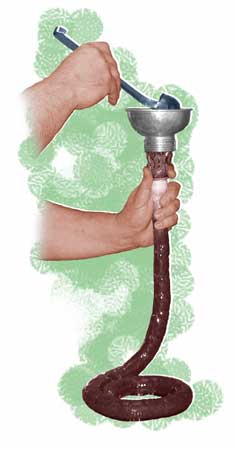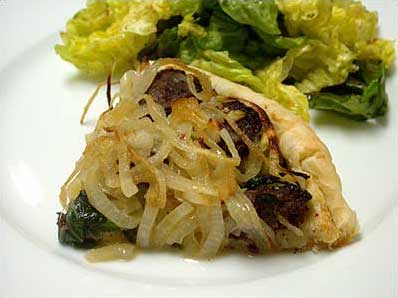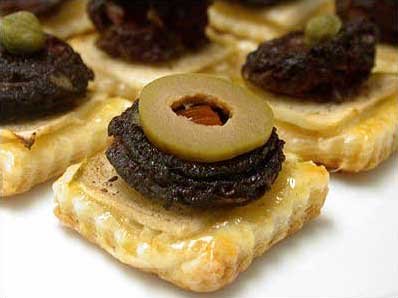


 Boudin noir — blood sausage — is one of France’s oldest charcuterie preparations. It’s part of a sausage making tradition in France that has lasted well over 2000 years. “There is evidence of the activities of the lardarius, the Gaulish charcutier, in a number of bas-reliefs and inscriptions found at Narbone, Bordeaux and Cologne, and at Rheims, where a bas-relief shows two of these specialists at work…. All the items of charcuterie shown in the relief are easily identifiable: [blood sausages], strings of sausage, joints of pork, pig’s heads.”1 Although the raising and subsequent slaughter of the family pig was common in the French provinces up to the Second World War, today few families in the countryside raise their own pigs.2 The slaughtering process, usually performed in late-November, required the whole family plus a few neighbors to work from dawn to dusk to first kill and bleed the animal, and then to butcher the carcass. The majority of the pieces were used to produce meat items that would sustain the family through the winter.3,4 These items would include hams, sausages, pâtés, and other preparations which preserve the pig’s flesh long past the time where fresh meat would have spoiled.
Boudin noir — blood sausage — is one of France’s oldest charcuterie preparations. It’s part of a sausage making tradition in France that has lasted well over 2000 years. “There is evidence of the activities of the lardarius, the Gaulish charcutier, in a number of bas-reliefs and inscriptions found at Narbone, Bordeaux and Cologne, and at Rheims, where a bas-relief shows two of these specialists at work…. All the items of charcuterie shown in the relief are easily identifiable: [blood sausages], strings of sausage, joints of pork, pig’s heads.”1 Although the raising and subsequent slaughter of the family pig was common in the French provinces up to the Second World War, today few families in the countryside raise their own pigs.2 The slaughtering process, usually performed in late-November, required the whole family plus a few neighbors to work from dawn to dusk to first kill and bleed the animal, and then to butcher the carcass. The majority of the pieces were used to produce meat items that would sustain the family through the winter.3,4 These items would include hams, sausages, pâtés, and other preparations which preserve the pig’s flesh long past the time where fresh meat would have spoiled.
When bleeding the pig, it was necessary to constantly move one of the forelegs to facilitate drainage and avoid the formation of clots that would prevent the blood from flowing.5 The warm blood had to be stirred to keep it from coagulating. This task often fell to the children. Today in France, the blood is removed from the pig with a vacuum system and immediately centrifuged to prevent it from solidifying.6 Pork blood consists of 77% water, 7.2% albumin, 14.5% globulins, 0.3% fibrin, 0.2% fat, and 0.8% other substances. Centrifuging breaks down the fibrin and inhibits coagulation. The blood will still coagulate if cooked to between 70 and 80 °C (158 to 176 °F).7
Blood sausages are very perishable and are often produced on a daily basis in French charcuteries.8 The sausage is produced in long, undivided lengths from which the patron purchases a cut piece, or in individual links. In the home kitchen, these sausages should be eaten within a day or two of preparation, or frozen until needed.
Each producer of blood sausages has his own recipe where the ingredients and proportions differ from those of the shop down the street. Traditional boudin de Paris will contain equal quantities of blood, fat, and cooked onions, but the proportions can vary widely. Different seasonings may be used, fruit or vegetables may be added, and various aromatics may be included. Common additions include apples and chestnuts.9
For the most part, the preparation of blood sausage is similar to making other types of pork sausage. The details of sausage preparation were published previously on this web site. The recipe accompanying this article leaves out many of the details already covered on that page.
One notable difference between the making of blood sausages and other types of sausages is that a stuffer is not used for filling blood sausages. For blood sausages, the casing is slid over the spout of a funnel and the sausage mixture is ladled into the funnel. In France, metal funnels appropriate for stuffing are available, but I was not able to find a suitable one in my neighborhood. However, I was able to fashion a usable system from the combination of a canning funnel, a disposable pastry bag, and a standard sausage stuffing tube. To make this sausage you will need a wide-mouth funnel with a straight spout.
The basic recipe for boudin noir presented herein is based on a recipe for the sausage presented by Charles Barrier, a Michelin-starred chef from Tours in the Loire Valley at the Ecole de Château d’Amondans in the mid-1990s. Chef Barrier’s original recipe didn’t use apples, but when I learned this recipe from Chef Frédéric Médigue at the Château, apples had been added and the fat reduced.
Blood sausages are commonly eaten fried or grilled and accompanied by potatoes and/or apples. In boudin grillé en compote de pommes citronnée et fruits secs, the sausage is simply grilled and served with a warm compote prepared from apples, lemon juice, and dried fruits. In émincé de boudin noir aux pommes (et aux pommes de terre), the blood sausage is sliced before grilling and is served with caramelized apple wedges and fried potatoes. In tarte au boudin noir et aux deux pommes, the same ingredients along with onions are combined into a pleasant tart. In bouchées croustillantes au boudin noir and feuilletés aux pommes et boudin, the sausage is used with apples to produce bite-size portions suitable for serving as an amuse-bouche. Lastly, crème de boudin noir, a soup, is the preparation that set me on my course of study to learn how to make my own blood sausages. The dish was originally called boudin maison servi comme un velouté, relevé au pigment antillais et quelques des d’ananas — homemade blood sausage prepared as a cream soup and seasoned with red peppers and pineapple — when I learned the recipe from Chef Médigue of Le Château l’Amondans in October, 2001. (I thought some simplification of the name was in order.)

- Toussaint-Samat, Maguelonne. A History of Food. Translated by Anthea Bell. Cambridge: Blackwell Publishers, 1994, p. 411.
- Ibid., p. 412.
- Ibid., p. 413.
- Grigson, Jane. Charcuterie and French Pork Cookery. New York: Penguin Books, 1967, p. 7.
- http://www.saosnois.com/boudin.htm (in French).
- Frédéric Médigue, conversation with author, Amondans, France, October 2001.
- Marcel Cottenceau, Jean-François Deport, and Jean-Pierre Odeau. The Professional Charcuterie Series. Translated by Anne Sterling. New York: Van Nostrand Reinhold, 1991, p 1:198.
- Ibid., p. 200.
- Larousse Gastronomique (in English), New York: Clarkson Potter/Publishers, 2001, p. 120.

©2002, 2014 Peter Hertzmann. All rights reserved.










